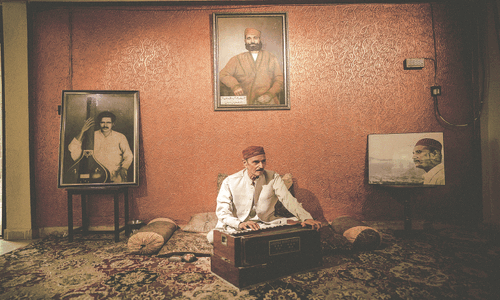Covid-19 has taken the lives of thousands of people. Some of them were well-known but no victim of the virus was as towering as the nightingale of South Asia, Lata Mangeshkar.
The velvet-voiced singer was admitted to Mumbai’s Breach Candy Hospital on January 11. At one stage, her health seemed to have improved and she was moved out of the ICU, but her pneumonia lingered and she passed away on February 6, leaving millions mourning her. As was only fitting, she was given a state funeral and the national flag was downed to half-mast.
Remarkably, during a career spanning more than half a century, the thrush-throated singer had crooned not just in Urdu/Hindi and her mother tongue Marathi, but in 36 languages — spoken in and out of the Indian Subcontinent.
Lataji, as she was fondly called by one and all, had won many awards, including the Bharat Ratna, the top-most civilian award in India, and the Dadasaheb Phalke, the highest award given to an individual connected with movies. Her list of Best Singer awards and Lifetime Achievement awards are far too many to be recounted. A mention should, however, be made of the coveted National Order of the Legion of Honour — the highest French order of merit award, both civil and military — bestowed on her by the French Government in 2007. She was also inducted into the Rajya Sabha, the upper house of Indian Parliament, a brief stint she never really much cared for.
The Nightingale of South Asia, Lata Mangeshkar, passed away on February 6. Her career spanned almost six decades and her immortal songs have defined the soundscape of many a generation
Lata was born in Indore on September 28, 1928 in a family steeped in music. Her father, Deenanath Mangeshkar, was a music composer. She got her initial training from him but, as bad luck would have it, he died early. She was then merely 13 and was left to support the family comprising three sisters, Usha, Asha (who acquired the surname Bhosle after her brief marriage), Meena and brother Hridaynath Mangeshkar, who took to composing.
The family moved to Bombay (now Mumbai) for better opportunities, where Master Ghulam Haider gave her a break in a movie called Majboor (1948). However, the movie that really launched her in a big way was Mahal (1949), and the song that catapulted her to fame was ‘Aayega, aayega, aaneywala.’
The song had two parts, the first part slow in the tempo, the second fast. It was picturised on the Venus of the Indian screen, Madhubala, who too was catapulted to the uppermost echelon in the field of acting for her performance in the film. The movie was embellished with two more lilting Lata numbers — ‘Mushkil hai bohat mushkil’ and ‘Dil ne phir yaad kiya’.

Before the Partition of the Subcontinent, when the reigning queen of movies, Noor Jehan, was in Mumbai, she guided Lata, particularly in the rendition of words. The two singers remained on the best of terms and, once, after the division of the Subcontinent, the two vocalists met on the Wagah border and had lunch together. Lata is said to have enjoyed the biryani that was brought by the senior singer. They parted with the commitment that they would converge on the border once every year, but the rift between their two countries became wider and their plan had to be dropped.
Back to ‘Ayega, ayega, aaney wala’ — one may like to recall that the Gramophone Company of India issued the 78rpm record with the name Kamini (which was the heroine’s name in the movie) printed on it. Thus, when the song was broadcast in request programmes from radio stations, announcers mentioned Kamini as the singer’s name. Lata took a stand, and the practice — or shall we call it malpractice? — had to be stopped.
A SMALL SELECTION OF LATA MANGESHKAR’S IMMORTAL SONGS

This was not the only time Lata revolted against prevalent norms in the film industry. In the sixties, she led other playback singers to demand royalty on their ditties. Mohammed Rafi, however, opposed the move as he maintained that, once a song had been recorded and the singer had been paid his or her fee, he or she had no monetary claims on the number. The rift between the two legends came to an end a few years later.
Because of her sparkling voice, Lata was almost always the first choice of music directors — except for O.P. Nayyar, who groomed her sister Asha Bhosle. When this writer had questioned the composer in an interview for Herald in late 1992 about what was described as his idiosyncrasy regarding Lata, he had replied that “She is a great singer in her own right, but it’s just that her voice doesn’t suit my compositions.”

In her interviews, Lata often recalled the incident when a remark by Dilip Kumar had changed her life. Dilip Sahib had, according to her, once told her that unless she learnt how to enunciate Urdu words correctly, she would never make it big in films. Lata was, of course, Marathi-speaking and film songs were, by and large, penned in Urdu. Stung by the remark, Lata engaged a maulvi sahib to teach her Urdu.
She later valued the remark by Dilip Sahib (nee Yusuf Khan) and, for the rest of her life, referred to him as Yusuf bhai, who in turn appreciated the fact that her voice was a ‘qudrat ka karishma’ [nature’s miracle]. He said this publicly while speaking at London’s prestigious Royal Albert Hall, where she was only the second Indian invited to perform. Sitarnawaz Pandit Ravi Shankar had preceded her.
At concerts or in sound recording rooms, Lata took off her shoes because she likened music to ‘ibadat’ [prayer]. She put her heart and soul in the songs that she rendered. A convenient example is the ‘naat’ from Mughal-i-Azam (1960), ‘Bekas pe karam keejiye Sarkar-i-Madina’.
Listening to the devotional number, one doesn’t ever get the feeling that the number was recorded in the voice of a non-Muslim. A parallel could be drawn with the bhajan recorded by a Muslim for Baiju Bawra (1952) — ‘Man tarrpat Hari darshan ko aaj.’ The singer of that bhajan was none other than Mohammed Rafi. Coincidentally, both the numbers were composed by Naushad, the maestro with the Midas touch.
Lata infused a depth of liberal feelings in the song ‘Allah tero naam, Ishwar tero naam’ for the anti-war film Hum Dono (1961). However, a more touching rendition was the national song ‘Aey mere watan ke logo’, which was written by Kavi Pradeep and the number was played after the 1963 Sino-Indian armed conflict, which saw a large number of Indian soldiers laying down their lives.
It is said that the then prime minister, Jawaharlal Nehru’s eyes became wet when he heard the song. By the way, one can’t recall her recording any such song during or after the Indo-Pak wars of 1965 and 1971.

Browsing through the collection of Lata Mangeshkar’s film songs, this writer is struck by the fact that many of her numbers have remained immortal though the movies for which she had sung them have been forgotten.
In conclusion, one would like to recall the great Ustad Barray Ghulam Ali Khan’s remark about Lata: “Kambakht kabhi besuri nahin hoti” [She never goes off-key].
Who can be a more qualified judge than the stalwart that Khan sahib was?
Published in Dawn, ICON, February 13th, 2022




































